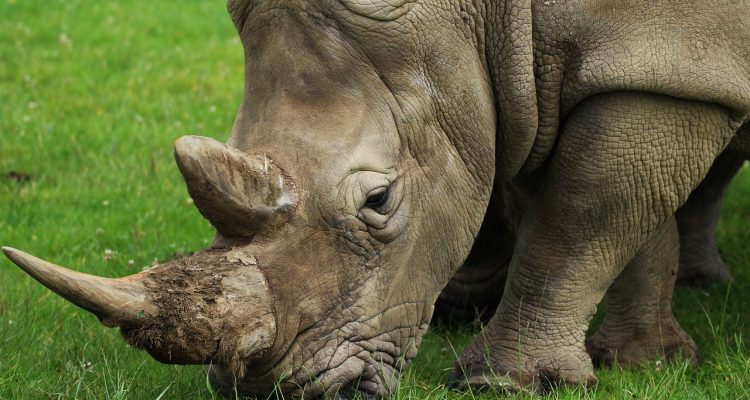A man was killed after an elephant charged him while he was walking in Kruger National Park, South Africa on Monday, April 8. After he was killed, his friends carried him to a road so a passerby could find his body, and then they promptly disappeared. The next day on, Tuesday, April 9, authorities told the man’s family about his fate. His body was finally found by Thursday morning on April 11, but the only parts that were left of the man were his skull and pants. Everything else was devoured by a pride of lions.
This might sound like a horror story about a tourist walking too far off the trail, but it is actually the story of a poacher illegally trying to hunt and kill a rhino, a notable member of the endangered species list. Why were the man and his three accomplices trying to poach a rhino? It was for a specific piece of the animals anatomy: its valuable horns.
Both on the endangered list, rhinos and elephants in Africa are on a steady pace to become extinct in the next few years if we don’t put an end to poaching. Between 2002 and 2011, the global population of elephants decreased by 62 percent and reports have shown that 100 African elephants are poached for their ivory everyday. Rhino populations aren’t faring any better; in 2017 more than 1,000 rhinos were poached in South Africa alone.
Why are poachers killing these animals? Rhino horns are made out of keratin which is what our fingernails are made out of, so why are they so valuable? The answer is that individuals are placing rhino horns and ivory tusks at very high prices on the black market. Prices range around $1,500 per pound of ivory, and it turns out that four out of five poachers named income and food as the primary reason they started poaching. To a poor man trying to feed his family, $1,500 is likely double his yearly income. In fact, a survey conducted at the Ruaha National Park in Tanzania found that out of 173 poachers surveyed, 96 percent said they’d cease poaching if they could find a better source of income. Since this is the case, I see the poachers as another set of victims in a very unfortunate situation. At the end of the day these are just people trying to do whatever it takes to support their families.
Although I don’t blame the poachers themselves, I do blame another particular group of individuals: the buyers. Without the buyers, nobody would be there to enable these people to poach these animals in the first place. The buyers are enablers, and their desires are what lead people into doing their dirty work for hefty prices. Around 90 percent of ivory consumers tend to originate from China, and the consumer base doesn’t seem to be slowing down with their consistent demand for ivory-crafted products. Known as “white gold,” ivory is seen by buyers, who tend to be women of the middle-upper class, as a sign of social status, wealth and cultural significance. It’s a way for people to flaunt their wealth and feel superior to others.
We should educate these people on why the purchasing of ivory is harmful and how it has had a detrimental effect on wildlife, but ironically the majority of ivory buyers actually support banning the sale of ivory. Buyers already know what their ivory-hungry desires are doing to the last remaining elephants and rhinos this world has, however they simply don’t care. Buyers want to look pretty, feel good about themselves and forget that their decisions actually have consequences that affect others. Perhaps one day, when the last elephant or rhino has gone extinct and their child asks why they can’t see them at the zoo anymore, they’ll look at their ivory possessions and realize the irreversible mistakes that they’ve made. Only when the problem has finally reached and touched their hearts will they understand what everybody has been fighting for this whole time.
I feel bad for the poacher that was killed that fateful night, as he was most likely just another part of a very sad system of poverty, greed and carelessness. I do feel that action has to be taken to discourage and ban the purchasing of all ivory products in order to stop people’s hunger for “white gold.’’ If they do ban all ivory products, it would be smart to ban all ivory regardless of whether it exceeds a certain age. In the U.S for instance, ivory must predate the year 1973 to be bought or sold. Even if the ivory is old, it still keeps consumer appetite for ivory alive and well, increasing the chance that consumers will seek more of the product through illegal means such as poaching. Bans like this are an action that should be taken by the governments of China, Cambodia, Laos and Vietnam to both enforce and encouraged the end of ivory sales. Thankfully, independent groups of activists such as VetPaw, a group that sends U.S Military Vets to Africa to help patrol national parks in search of poachers, are doing their part in helping to minimize the damage poachers cause. Independent groups are very helpful, but it ultimately comes down to national governments forming more strict laws by simultaneously banning the acquisition of ivory merchandise and utilizing wildlife protection campaigns to educate them on the issue at hand. Hopefully further action will be taken soon because at this rate, the next generation of kids will grow up not even knowing what a rhino or elephant is.


Leave a Reply